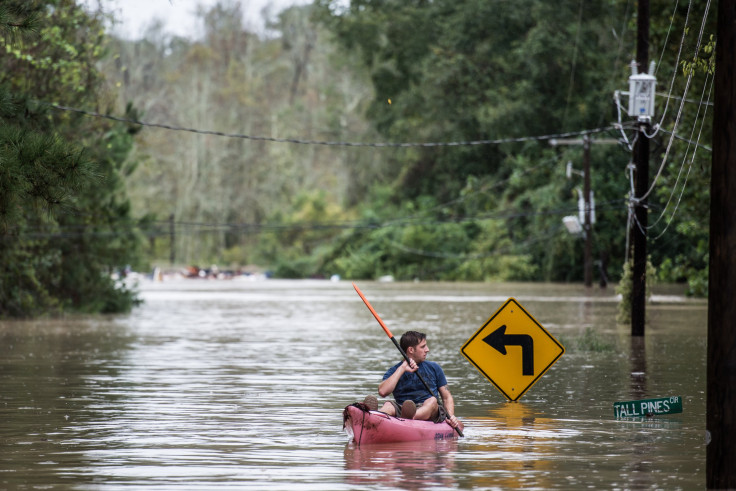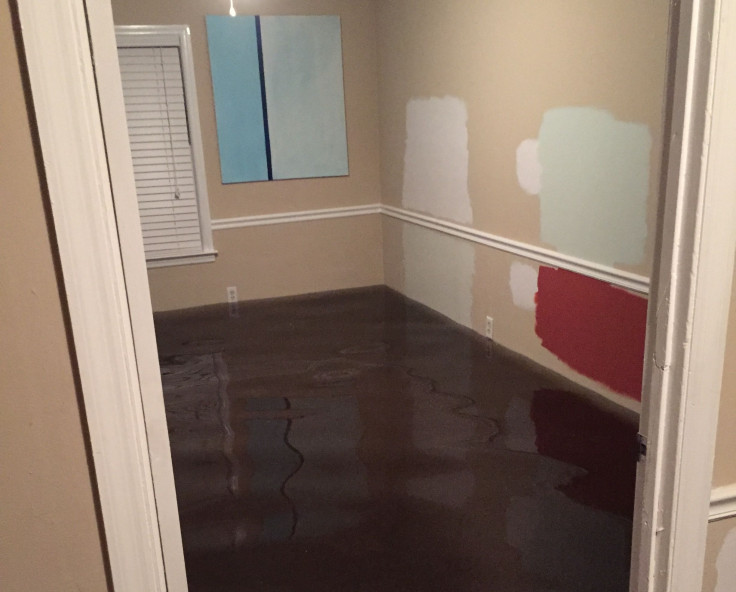South Carolina Flooding: Real Estate Boom At Risk As Threats From Climate Change Intensify

In Summerville, South Carolina, deep rivers of muddy water coursed through the streets of the Cane Bay Plantation subdivision this week as record rainfall pounded the state. Residents in the suburban enclave of vinyl-sided homes and lush green lawns were briefly stranded by rains creeping above car tires and crumbling chunks of nearby roads.
The 2,000-home development is part of an ongoing real estate boom in Berkeley County, which sits about 30 miles north of the coastal city of Charleston and nearly hugs the state’s Atlantic shoreline. Workers are flocking to the area to land jobs with the nearly two dozen major employers, including aircraft giant Boeing Co. and German automaker Daimler AG. State politicians and officials, meanwhile, are pushing to accelerate development and satisfy rising demand from middle-class residents and employers.
But the local surge in population and housing is taking place in South Carolina’s lowest-lying region, where rivers and creeks are prone to overflowing and the wetlands -- now covered by dirt and concrete -- tend to flood during storms. Weather-related threats in the state's Lowcountry are expected to rise in coming decades as climate change leads to more extreme flash flood events, stronger storm surges and rising sea levels, climate scientists say.
“Development is occurring at a very fast pace, and trying to keep up with that pace -- and doing it in a smart way -- is a big challenge,” said Elizabeth Fly, the coastal climate extension specialist for the South Carolina Sea Grant Consortium, an academic research program. “How do we manage the growth of our region with our natural environment and hazards that we’re seeing more frequently?”
South Carolina suffered catastrophic flooding following historic rains on Saturday, Sunday and into early Monday. At least 11 people have died in South Carolina and two in North Carolina from weather-related incidents since the weekend, and tens of thousands of residents remained without power or drinking water early Tuesday. While rainfall has largely subsided, meteorologists are warning the flooding could continue this week as rivers swell and smash through dams.
“This is an incident we’ve never dealt with before,” South Carolina Gov. Nikki Haley told reporters Sunday. “We are at a 1,000-year level of rain,” she added, referring to a storm with a 1-in-1,000 chance of striking in any given year. “That’s how big this is.”
Economic losses from the catastrophe will easily exceed $1 billion, global reinsurance broker Aon Benfield said in a report this week. By comparison, South Carolina has suffered damages of over $7 billion in the past 12 years from flooding and hurricane events, according to the state.
Only a sliver of residential properties damaged this week are covered by federal flood insurance. South Carolina has nearly 200,000 National Flood Insurance Program (NFIP) policies in place, or roughly 9 percent of the total number of housing units in the state, according to federal statistics. Residents who live in floodplains designated by the Federal Emergency Management Agency (FEMA) are required to have NFIP protection, but flood insurance is optional for most everyone else.
“It’s a very good reminder that just because FEMA designated a floodplain, it doesn’t mean the flooding will only be there,” Fly said, pointing to her own house in the West Ashley neighborhood of Charleston. Fly and her husband didn’t have flood insurance for their 1960s-era split-level home, which took in more than a foot of water over the weekend, destroying newly installed hardwood floors and a washing machine in the lower level.
“Our neighbors who have lived here for decades, they’ve never seen flooding like this,” she said. “Many people that aren’t required to get flood insurance don’t. But we’ll look into getting flood insurance now.”

About a half-an-hour drive north of West Ashley, residents in the Cane Bay subdivision were grappling with similar conditions. Resident Tamara Lance said she was stuck in her home Monday evening because the water in the streets was about 2 feet deep. “Our road turned into a river,” she told the Weather Channel. Still, she said her situation could be much worse. Houses in Cane Bay are slightly elevated and were spared significant flood damage. In other parts of Summerville, houses were nearly halfway submerged and about 50 people were evacuated over the weekend.
Cane Bay is among a handful of ambitious mega-developments planned in Berkeley and neighboring counties, spurred by rising demand for middle-class housing and the region’s post-recession recovery. Formerly rural zones marked by swamps and lakes are transforming into suburban hubs, replete with new public school buildings, shopping malls, town centers and office spaces sprawled across thousands of acres. More than 75,000 people are expected to move into the Cane Bay, Nexton and Carnes Crossroads subdivisions once construction is finished in the next two decades, according to local news reports.
The developer of Cane Bay Plantation did not respond to a request for comment. A spokesman for WestRock, the Nexton developer, declined to offer comment. But he said none of the Nexton properties, which began housing residents in February, were affected by flooding this week.
Many of the new development projects in Berkeley County and surrounding areas involve building over the freshwater wetlands that span the coastal region, said Amy Armstrong, executive director of the South Carolina Environmental Law Project. Filling in wetlands can make draining and managing stormwater more complicated compared to other geographies.
“When you fill them in, you lose that sponge activity, that ability to hold and retain floodwater,” Armstrong said. “That increases the surface runoff and exacerbates flooding. You’re making it more difficult to respond to these kinds of historic events.” At the same time, developers are building alongside rivers on lower-elevated terrain, since much of the higher-elevation ground is already occupied.
Nice little pond action going on in the middle of the street! #BerkeleyCounty #CaneBay pic.twitter.com/Fx3hrp6a51
— RaShan Frost (@RaShanFrost) October 4, 2015Just hope that porta potty doesn't tip over... #CaneBay #BerkeleyCounty pic.twitter.com/k7NSzVtzIf
— RaShan Frost (@RaShanFrost) October 4, 2015Yet at least a half dozen bills in the South Carolina Legislature would boost business development and accelerate real estate growth in the state’s coastal regions. State legislators are considering a bill that would cut regulations protecting wetlands and rivers in the interior sections of coastal counties. Another measure would allow construction projects to be built while environmental permits are under appeal. That bill would eliminate the “automatic stay” that’s placed on projects under dispute, enabling companies to develop wetlands while appeals wend their way through the courts.
Mike Wooten, South Carolina’s transportation commissioner, this spring railed against environmental groups and urged state senators to consider the measures. “It is time for this nonsense to stop and that individuals and groups who seek to delay construction of much-needed roadway projects, our port and other projects … be held accountable for their actions,” he told a Senate subcommittee in March, The State newspaper in Columbia reported.
Environmental advocates like Armstrong say the rollbacks would weaken South Carolina’s ability to respond to the threats of climate change. Already in Charleston, so-called “nuisance flooding” is rising exponentially, in part because of sea level rise. Nuisance floods are minor events that shut down roads and clog storm drains but aren’t as devastating as the events unfolding this week.
Charleston had an average of 23.3 days per year of nuisance flooding from 2007 to 2013 -- a 400 percent increase over the period from 1957 to 1963, when Charleston averaged 4.6 flood days per year, the National Oceanic and Atmospheric Administration found in a 2014 report. Across the East Coast, such floods have increased by more than fivefold since the 1950s.
In Charleston Harbor, sea level has risen 10 inches over the past 80 years as melting ice caps and warmer water expand the ocean, and as South Carolina’s coast erodes due to natural forces and man-made development. By the end of this century, one in six homes could be inundated if sea levels rise by 4 feet, according to projections from Climate Central, a research organization.
At the same time, heavy downpours will likely strike more frequently and with more ferocity in coming decades as warming global temperatures influence weather patterns. Excess rain will overwhelm drainage systems, causing standing water in streets and yards, and burden local septic systems, leading to contaminated drinking water. The most dangerous flash flood events will weaken or damage roads, bridges, dams and properties while burying highways and evacuation routes.
Critics of Gov. Haley’s administration say the state isn’t acting fast enough to prepare South Carolinians for climate change. The Department of Natural Resources recently came under fire for hiding a 2011 report on six major climate threats to the state, including “detrimental change” to ecosystems, the abundance and quality of water and sea level. TheState.com posted the unpublished report in February 2013, prompting the agency to eventually share the report on its own website.
“South Carolina doesn’t do a lot, if anything, to assess how the frequency and magnitude of natural disasters like floods and coastal erosion will change in response to climate change,” said Rob Moore, a senior policy analyst with the Natural Resources Defense Council’s water program in Chicago. He noted that the state’s hazard mitigation plan relies largely on historic disaster data, and less on future climate projections, to assess South Carolina’s level of risk.
“That approach is fine and dandy as long as the future looks exactly like the past,” he said. “But climate change totally changes that equation.”
Fly, the coastal researcher in Charleston, said many of the local communities she works with at the South Carolina Sea Grant program are aware of the threats they face from climate change and are discussing strategies to protect people and property from future hazards. “But not as many places are to the next stage of actually implementing that stuff,” she said. But noting her own flooded house, she added, “There’s only so much preparation that an area can do.”
Moore said he hoped South Carolina officials and residents would heed the lessons from this week’s catastrophic floods. “Any time you have major flooding, in the aftermath the most immediate pressure is to rebuild,” he said. “Rebuilding shouldn’t just be about putting things back the way they were. It’s the perfect time to be thinking about where we should rebuild, and how we should rebuild it so that we don’t incur the same damages.”
© Copyright IBTimes 2024. All rights reserved.





















